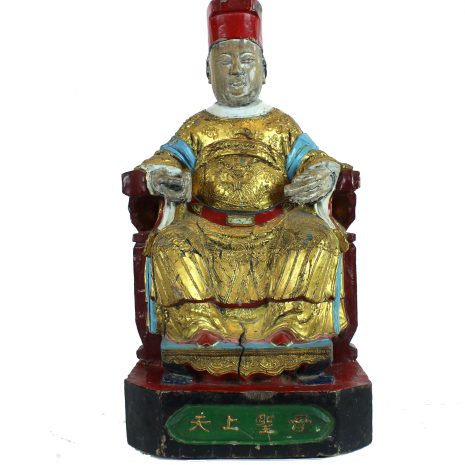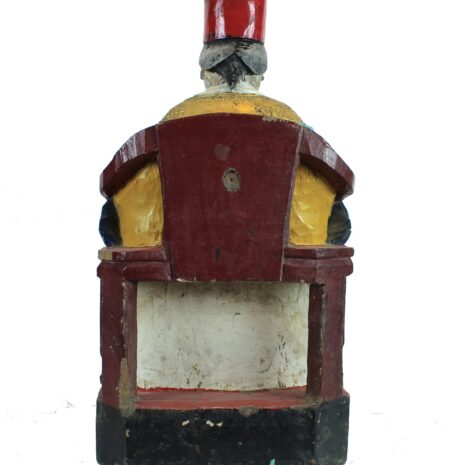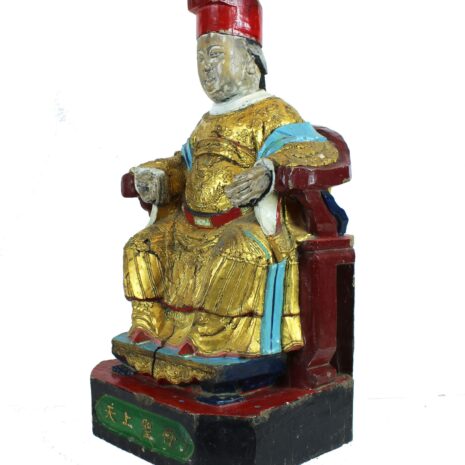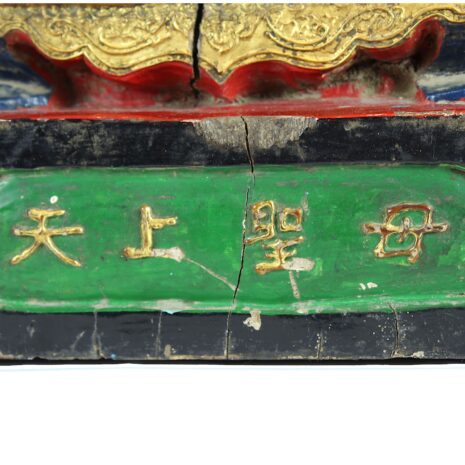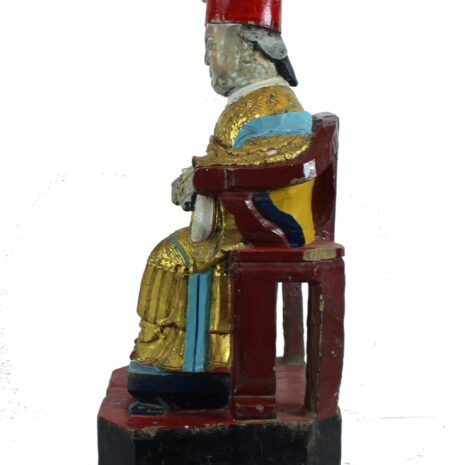Antique Mazu “Holy Mother in Heaven,” China, (3429)
Original price was: $1,450.00.$875.00Current price is: $875.00.
H: 19.25″ W: 10″ D: 8.75″ |CALL 213-568-3030 OR EMAIL [email protected] FOR SHIPPING.
Seated imperiously on a horseshoe chair with carved title “Holy Mother in Heaven,” Mazu is depicted in the imperial style, with a regal flat topped headdress, elaborate robes with dragons, official’s girdle in red and gilt. In excellent condition after years of use.
Description
Mazu has been one of the most popular Taoist-deities in southeastern coastal China since the early Song dynasty, a syncretic goddess revered by followers of Buddhism and Popular Religion and one of the Great Chinese Goddesses (Irvin). Mazu was a legendary young female shaman named Lin Mo who used her powers to save seafarers and became their tutelary deity. Legends about her prowess spread throughout China and Southeast Asia and when she died at age 28 she became the cult figure “the Protector at Sea.” She was canonized and raised to the highest rank of a female. In 1664 she receiving the title “Holy Mother in Heaven” which is carved with gilt on this image and “Empress of Heaven” in 1737. New myths about her feats and filial piety that attested to her noble background were created. One myths described how at her death she reached a mountain top to meet her destiny and was engulfed by clouds while music played, a bright orange and gold light carried her to the heavens, and a rainbow appeared. In Taoist mythology a rainbow represents dragons (seen on her dragon robes), mythical animals who are a link between earth and heaven and bring good fortune and blessings to those in their presence. The rainbow colors in here also symbolize the five Taoist elements and orange is strongly associated with Bodhisattvas who stay on earth and help others. Seated imperiously on a horseshoe chair, this majestic Matsu was carved from a single piece of dense wood, legs resting on a turquoise embossed pedestal set on a base. Her elaborate gilt robe has a white collar, a red girdle at the waist flowing to her shoes and is meticulously detailed using a blend of sawdust and gesso to form raised textured motifs that include clouds, a dragon framed by her girdle, and a flying dragon on each shoulder. She wears a red imperial flat headdress. Layers of polychrome red and gold leaf are highlighted with lacquer creating an effect reminiscent of gilded bronze sculpture with the large amounts of gold associated with enlightenment. It is in excellent condition with the polychrome on her face and hands having been removed revealing a white stucco undercoating. This antique woodcarving shows the decorative influence of Taoism on Qing carvings of this era.
Source:
Lee Irwin, “Divinity and Salvation: The Great Goddesses of China,” in Asian Folklore Studies, Indiana University, Vol. 49, 1990, pp 53-68.
Claudia Monique, “Matsu/Mazu Goddess of Sea,” May 20, 2014.
Additional information
| Place of Origin | China |
|---|---|
| Period | Antique, Qing Dynasty |
| Date | 19-20th Century |
| Materials and Technique | Wood |
| Dimensions (inches) | Ht: 19.25” W: 10” D: 8.75” |
| Dimensions (metric) | : Ht: 48.9cm W: 25.4 cm D: 22.2cm |
| Weight | 11lbs 7oz |
| Condition | Very good, patina and wear consistent with age and use |
| Item Number | 3429AEM |
| Shipping Box Size | Oversized. Call 213-568-3030 or email [email protected] for shipping. |

